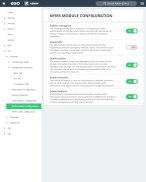Display additional tabs to gather data
You can activate the display of additional tabs in the fire Incidents module, so that your agency can collect additional information as needed. You can also deactivate the display of these tabs at any time, if the agency no longer wants to collect the data.
-
Do one of the following.
-
(If you are already working in the ESO Suite) Click the Home icon in the upper left corner of the screen.
-
 (If you have not yet logged in) Log in to the ESO Suite.
(If you have not yet logged in) Log in to the ESO Suite.
-
In a web browser, go to https://www.esosuite.net/EsoSuite.
The ESO Suite login screen appears.
-
Enter your user name, password, and agency name, then click Let's Go.
If MFA is enabled, the Multi-factor authentication dialog box appears, displaying one or more methods you can use to verify your login credentials. The number of methods that appear in the dialog box depends on what MFA methods your ESO Suite administrators enabled in the Admin module.

Click graphics
to open them.Information on enabling MFA and specific MFA methods is available in the Admin module online help, in Configure multiple-factor authentication.
Note: If your ESO Suite administrators have disabled MFA ("opted-out"), this dialog does not appear.
-
(If the Multi-factor authentication dialog box appears) Depending on which buttons appear in the dialog box, verify your login in one of the following ways.
 With an authenticator application.
With an authenticator application.
-
Click MFA verification via authenticator app.
The dialog box updates with boxes for entering the numbers of the authentication code, and the ESO Suite sends an authentication code to the authenticator application installed on your device.
-
Open your authenticator application and note the authentication code currently displayed.
-
Enter the authentication code displayed in the authenticator application.
-
Click Log In.
 With a text message (SMS).
With a text message (SMS).
-
Click MFA verification via SMS.
The dialog box updates with boxes for entering the numbers of the authentication code, and the ESO Suite sends an authentication code to the phone number recorded in your PM records and identified with MFA codes.
-
Enter the authentication code sent to your MFA-registered phone number.
-
Click Log In.
 With an email message.
With an email message.
-
Click MFA verification via email.
The dialog box updates with boxes for entering the numbers of the authentication code, and the ESO Suite sends an authentication code to your agency or department email address, recorded in your PM records.
-
Enter the authentication code sent to your agency or department email address.
-
Click Log In.
-
-
The ESO Suite landing screen appears.

Click graphics
to open them.Note: You can access and manage your MFA options through the PM module, on the Settings > Account page, as described in Manage a user account. If your agency or department has enabled MFA but has not purchased the full-featured version of the PM module, you can access your own MFA settings by clicking Change my Multi-Factor Authentication settings on the landing screen, then using the Settings > Account page that appears. If your agency has not enabled MFA, the Change my Multi-Factor Authentication settings link does not appear on the landing screen.
-
-
On the top side of the home screen, click Admin.
Tip: If your screen or browser window is too narrow to display all your agency's ESO Suite module icons, an options icon appears on the right side of the icon bar. If you click the options icon, a menu appears containing additional module icons.
The Admin screen appears, displaying the Welcome screen.
-
In the left pane, expand Fire > Incidents, then click NFIRS Module Configuration.
The NFIRS Module Configuration screen appears.
-
For any of the tabs you want to display in the fire Incidents module, on the right side of the list, drag the slider button to the right, until On appears.
Activate this To do this Enable Investigation
Collect standardized information and integrate with the Bureau of Alcohol, Tobacco, and Firearms' Arson and Explosives National Repository.
This tab is optional.
Enable EMS
Collect information as a local option, when the fire department provides emergency medical services (EMS).
Note: This information does not replace or otherwise interfere with state or local EMS patient reporting requirements.
Enable HazMat
Collect aggregated data on incidents, which may provide invaluable information for policy makers who develop regulations for storage, use, and transportation of hazardous materials. This data may be used to develop recommended guidance for emergency personnel response.
This tab is optional.
Enable Personnel
Collect information as a location option, to identify personnel sent to each incident. This data provides administrators with information that can be used for management strategy development.
Enable Wildland
Collect information about the nature and magnitude of wildland fire problems. It permits wildland fires to be profiled in details for resource allocation, incident management, and fire impact analysis.
This tab is optional.







